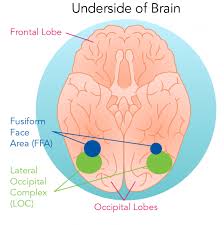
The fusiform face area is a part of the human visual system that is specialized for facial recognition.
It is located in the inferior temporal cortex, in the fusiform gyrus which is Brodmann area 37
The FFA is located on the ventral surface of the temporal lobe on the lateral side of the fusiform gyrus.
It is lateral to the parahippocampal place area.
It is usually being larger in the right hemisphere.
Comparing the neural response between faces and scrambled faces will reveal areas that are face-responsive, while comparing cortical activation between faces and objects will reveal areas that are face-selective.
The FFA is composed of functional clusters, that electrical stimulation selectively distorts face perception, which is causal support for the role of these functional clusters in perceiving the facial image.
There is some activation in the FFA when car experts were identifying cars and when bird experts were identifying birds.
Face perception evoked by face-like objects is a relatively early process, and not a late cognitive reinterpretation phenomenon.
The fusiform face area is specialized for processing faces in a normal orientation.
Activity in the FFA codes for individual faces and is tuned for behaviorally relevant facial features.
An electrocorticography study indicates that the FFA is involved in multiple stages of face processing, from when people see a face until they respond to it.
demonstrating the dynamic and important role
The FFA plays an important role in the face perception network.
Stronger activity in the FFA is generated when a person sees a familiar face as opposed to an unfamiliar one.
People identifying familiar faces have more activity in their right fusiform face area and participants that were poor at matching had less activity in their right fusiform area.
The FFA is also activated in people born blind.
FFA is activated by both familiar objects and faces.
Likewise, children with autism have been shown to develop object recognition at a similarly impaired pace as face recognition.
Autistic people have lower neuron densities in the FFA.
It is suggest that the FFA is intrinsically designed to recognize faces.
Prosopagnosia is related to FFA being essential to the recognition of unique faces.
The FFA is underdeveloped in children and does not fully develop until adolescence.
Children show the ability to differentiate faces: Three-day-old babies have been shown to prefer the face of their mother.
Babies as early as three months old have shown the ability to distinguish between faces, and exhibit the ability to differentiate between genders, with some evidence suggesting that they prefer faces of the same sex as their primary caregiver.
Infants do not appear to use the FFA for the perception of faces, as fMRI work has found no face selective area in the brain of infants 4 to 6 months old.
The countless facial expressions humans use that disturb the structure of the face.
These disruptions and emotions are first processed in the amygdala and later transmitted to the FFA for facial recognition.
The FFA is so far downstream in the processing of emotion suggests that it has little to do with emotion perception and instead deals in face perception.
The FFA is activated more strongly by fearful faces than neutral faces, implying that the FFA has functions in processing emotion despite its downstream processing.

One reply on “Fusiform face area”
To the standardofcare.com webmaster, Your posts are always well-supported and evidence-based.